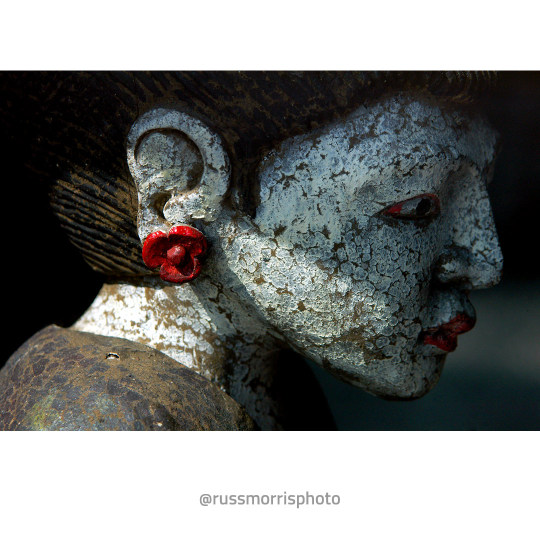#San Jose Museum of Art
Explore tagged Tumblr posts
Text
Returning to Creative Communities
Returning to Creative Communities
A few days ago, I headed out to a local park where my brilliant poet friend, Lorenz Mazon Dumuk, was hosting Glowing with the Moon, a summer open mic series that invites poets, musicians, performers, and other creative souls to come out and share their work. It’s one of my favorite open mics, mostly because Lorenz creates such a warm, welcoming, and fun space. Continue reading Untitled

View On WordPress
2 notes
·
View notes
Text


Ala Ebtekar, Thirty-Six Views of the Moon (from the San Jose Museum of Art)
400 notes
·
View notes
Text

'Symmetria', (1997 - Oil on canvas) by David Ligare (b. 1945), American painter - San Jose Museum of Art, CA.
85 notes
·
View notes
Text
13 notes
·
View notes
Text
Hey. Hey you, young person. Is there an art museum near you? Do you have access to going there?
Go there. Go look at some art.
Most museums offer a youth or student discount that also covers college students. Depending on your city there might even be a free contemporary museum or a smaller local gallery. Or you might be able to get free tickets to a bigger museum through your library card.
I know living somewhere with accessible museums is a luxury and I think that's a tragedy. I also know that there are younger people here whose parents won't allow them to take public transit to the local museum or gallery. I was severely neglected as a child and because of that I'm learning I had some strange privileges other people of that age don't usually get. But my point stands - if you live near an art museum, and you are able to, visit it. Preferably alone. At least check the website and see what exhibits are on view at the moment.
It's extremely valuable to see the scope of art in modern and classic ages. You don't have to be an artist to get use from this. Virtually everyone should have as much access as possible to be in the same physical space as a painting, sculpture, or photo that moves them.
There's also an opportunity to hear from voices you might miss otherwise. I checked the museum I went to growing up at least like once a month (youth tickets were six dollars) to see what was there right now and saw this exhibit. And like. I'm jealous. That sounds so cool. And then I looked up what was coming up to the San Jose ICA, and now I'm annoyed. I spent so many days taking myself to see art in person alone and then thinking about it.
Most modern art museums change exhibits more often compared to other museums. Some of them are artists from eras you might be familiar with, as they're pieces from the museum's individual collection. I saw an Edward Hopper painting in person and I stood so close to it that I practically touched my nose to the glass. But they also have new artists, underrepresented artists, and exhibits covering themes relevant to the world today.
See art if you can. Tell me about the art you see. Take a picture maybe - but ask permission first.
#clove rambles#i miss the art museum#theres another one at the university#but im not allowed to bike yet RIP
18 notes
·
View notes
Text

Frida and Diego RIvera
Artist: Frida Kahlo
Period: Naive Art
Genre: Portrait
Date: 1931
Medium: Oil Painting
Collection: San Francisco Museum of Modern Art, San Francisco
In Frida's painting of her and Diego, she recorded the up and downs of her marriage. She draws this painting, Frieda and Diego Rivera, 1931, as a wedding portrait. This was completed after two years of their conjugal life. In this painting, Frida adopted the stiff pose which is an influence of naive nineteenth-century painters such as Jose Maria Estrada, whose work influenced Diego Rivera also. An enlightening engraving on a strip in the snout of a pigeon (a gadget both Frida and Diego obtained from such craftsmen as Estrada and from well-known craftsmanship) is as straightforward in tone as the painting is folkloric in style:
"Here you see us, me Frida Kahlo, with my dearest husband Diego Rivera. I painted these pictures in the delightful city of San Francisco California for our companion Mr. Albert Bender, and it was in the month of April of the year 1931."
This painting, Frieda and Diego Rivera, indicates at what the Riveras' marriage would get to be. As solidly planted like an oak, Rivera looks colossal beside his wife. Dismissing from her, he shakes his palette and brushes - he is the extraordinary maestro. Frida, whose little feet scarcely brush the ground, cocks her make a beeline for her great mate. This painting shows her favorite image: the genius's adoring wife.
She was holding his hand with the lightest possible clasp. Frida understood that Diego belongs to nobody. Even while she was painting this portrait, Rivera was in an affair with tennis champion Helen Wills. He painted her nude image on the ceiling of the Luncheon Club of the Pacific Stock Exchange in San Francisco.
Later Frida was to remark:
"Being the wife of Diego is the most marvelous thing in the world … I let him play matrimony with other women. Diego is not anybody's husband and never will be, but he is a great comrade."
Nevertheless, she wanted to be his favorite comrade: in the exact center of her wedding portrait are the couple's hold hands holding together. The turning point of Frida's life was the marriage bond.
#portrait#diego rivera#frida kahlo#mexican culture#mexican painter#20th century#green dress#rebozo#hat#suit
3 notes
·
View notes
Text










Flying West (No. 6)
San Francisco and the surrounding San Francisco Bay Area are a global center of economic activity and the arts and sciences, spurred by leading universities, high-tech, healthcare, finance, insurance, real estate, and professional services sectors. As of 2020, the metropolitan area, with 6.7 million residents, ranked 5th by GDP ($874 billion) and 2nd by GDP per capita ($131,082) across the OECD countries, ahead of global cities like Paris, London, and Singapore. San Francisco anchors the 13th most populous metropolitan statistical area in the United States with 4.6 million residents, and the fourth-largest by aggregate income and economic output, with a GDP of $729 billion in 2022. The wider San Jose–San Francisco–Oakland Combined Statistical Area is the nation's fifth-most populous, with around nine million residents, and the third-largest by economic output, with a GDP of $1.32 trillion in 2022. In the same year, San Francisco proper had a GDP of $252.2 billion, and a GDP per capita of $312,000. San Francisco was ranked fifth in the world and second in the United States on the Global Financial Centres Index as of September 2023. Despite a continuing exodus of businesses from the downtown area of San Francisco,[43][44] the city is still home to numerous companies inside and outside of technology, including Salesforce, Uber, Airbnb, X Corp., Levi's, Gap, Dropbox, and Lyft.
In 2022, San Francisco had more than 1.7 million international visitors – the fifth-most visited city from abroad in the United States after New York City, Miami, Orlando, and Los Angeles – and approximately 20 million domestic visitors for a total of 21.9 million visitors. The city is known for its steep rolling hills and eclectic mix of architecture across varied neighborhoods, as well as its cooling summers, fog, and notable landmarks, including the Golden Gate Bridge, cable cars, and Alcatraz, along with the Chinatown and Mission districts. The city is home to a number of educational and cultural institutions, such as the University of California, San Francisco, the University of San Francisco, San Francisco State University, the San Francisco Conservatory of Music, the de Young Museum, the San Francisco Museum of Modern Art, the San Francisco Symphony, the San Francisco Ballet, the San Francisco Opera, the SFJAZZ Center, and the California Academy of Sciences. Two major league sports teams, the San Francisco Giants and the Golden State Warriors, play their home games within San Francisco proper. San Francisco International Airport (SFO) offers flights to over 125 destinations while a light rail and bus network, in tandem with the BART and Caltrain systems, connects nearly every part of San Francisco with the wider region.
Source: Wikipedia
#Don Edwards San Francisco Bay National Wildlife Refuge#Cargill Salt#San Francisco Bay Area#San Francisco#Oakland#Berkeley#Pacific Ocean#Golden Gate#San Francisco–Oakland Bay Bridge#Alcatraz Island#travel#original photography#vacation#tourist attraction#landmark#architecture#landscape#countryside#on board#plane#USA#deep blue sky#clouds#California#West Coast#farmland#fields#nature#flora#ships
6 notes
·
View notes
Text
Blood and Silicon Episode 7: New Territory, Part Two (Your Cross to Bear)
[Summary: We explore the territory; Pauline heads to church, Blake chats with a friend, and Leo only has more questions.]
(Putting in a Content Warning for mention of religion, just in case.)
The coterie reaches the territory, parking in front of the San Jose Museum of Art. Blake trails behind the other two, certain that there's a catch to all of this; Pauline is keeping an eye out for any drug dealers, criminals, etc. Leo's headache is pretty bad, and he excuses himself, saying he needs to take care of something. Pauline tells him to be safe as he leaves, and Pauline heads off towards the church on the territory. Blake gets a text but doesn't check it yet, and heads off to one of the sports bars.
As he gets closer to one, he hears something knock over a garbage can- he doesn't get a good look at whatever it was, but it was too big to be a cat. He activates his Eyes of the Beast; there's the end of a fox tail. Blake enters the bar (turning off his eye ability beforehand), and orders a drink. Checking his phone, Blake sees the text is from Wes, a character we haven't met yet, saying that the two of them should talk since it's been a while.
Meanwhile, Leo goes till he's sure the coterie won't see or hear him, and ends up near this circle of palm trees with benches; there's a bit of a weird vibe going on. He uses Auspex to see what's up in the circle; there's a bit of power in the center, but he can check that out later. As he gets closer, he sees someone on a bench- it's Chris, of backstory fame. Leo freezes and wonders how she even got here, he has a lot of questions, but also- he's got shit to deal with. He avoids her, and finds a spot to contact Jeremiah. He tries to ask his sire questions, but Jeremiah is currently frustrated about something, and refuses to elaborate or even answer Leo's questions. They both seem to only agitate each other further; Leo ends the conversation, kinda pissed off, and lights a cigarette as he walks away.
As soon as Pauline gets onto the steps of the church she gets an uneasy feeling. With Eyes of The Unseen, she sees that the place has a bad aura. She looks through a window and sees flyers and the like, advertising Spanish and English services during the day; The latest is at 7-9:30pm. The church is grand inside with stained-glass windows. The giant cross makes her uncomfortable, and she holds onto her own for comfort. She looks at the other flyers; there’s Christmas events that will happen at midnight. Pauline takes a photo of the schedule, planning to come over on Sunday.
She sits on the steps on the church, smoking a cigarette when she sees Leo approach. She asks if he's okay; Leo sits down next to her and grumbles about how Jeremiah never answers. Pauline asks him what he even expected, given how he was sent away with only a coat.
Pauline tells him she was adopted by other Kindred after her sire left her, and that she was raised Protestant. She had a crisis of faith, but it's not that she doesn't believe, its just hard to with everything around them. She doesn't think we’re alone. (Leo, however, says that he believes in the supernatural, but not in God.) While Pauline believes in God, she doesn't believe in the doctrine, saying how easy it would be for them to manipulate humans through the church, comparing them to dogs on a leash- She then adds that she has no intention of doing that, though.
She says that all Kindred are cut off from god, and that Jeremiah (her dislike of him is clear with how she said his name) cut Leo off from Heaven the moment he brought him back. She wishes she could spare him the pain, she tells him, and he admits that he thought he was going to go to Hell the night he was Embraced.
She asks to show him something, and leads him to the large cross she saw earlier. Leo feels the same unease as she did, and his Beast is afraid; he takes a small step back. Pauline almost reaches out to reassure him. Instead she quotes Leviticus 17:14, and tells Leo that partaking in the blood is the closest they'll ever get to divinity. Leo has a thought, but stays silent.
Meanwhile, Blake continues to text Wes- Wes mentions that unlike Blake, he needs to sleep, and Blake says his schedule recently freed up. They agree to meet the next night. Blake tips the bartender and sees which sports team wins before he leaves. He goes to the palm circle and sits down one or two benches away from Chris- her eyes are closed in meditation almost like she’s trying to focus. Blake sends a text to the group chat [Blake: "Sitting in this palm circle thing. Ready when you are."].
In the church, the Malkavians receive the message and make their way over to him. As they approach Blake at the Palm Circle, Chris finally opens her eyes and heads towards Leo. They both ask each other what the hell they're doing here- Blake looks up at this- and Chris asks what happened to him. She notices his coterie and seems a bit nervous at their presence. She tells Leo that the two of them should talk- but not here- and upon being asked, Leo tells her that Blake and Pauline are his acquaintances. Chris mentions how she doesn't like being as direct, but here, take this- and offers him a folded-up note.
As he goes to grab it, she snatches him by the wrist- he activates Blush of Life in a panic and his Beast whispers Chris is a liability, and she pulls him close and whispers: "You weren't you that month."
Leo gets a horrible feeling. She hurries off. [Blake and Pauline ask if Chris is going to be a problem; Leo tells them she's nothing to worry about. His headache is worse.] They other members once again remind Leo to keep people at an arm's length, and they make a note about predators- and speaking of predators, Blake mentions the fox. Pauline refers to it as a kistune, and Leo tries to explain what yokai are to Blake.
As Blake and Pauline discuss payment methods [Blake gets 400 bucks I think, I didn't get any of that], Leo checks Chris's note; it's a time and place to meet up with her. He writes this down in his notebook as well as other things, because he's connecting some dots in his brain, and scribbles down "We seriously need to fucking talk."
Leo tells the coterie he's going to feed; Blake directs him to the sports bar, and Pauline says if he messes up, just tell her and she'll use Dominate to make them forget. ["I don't want that." "Then don't mess up!" "I won't!"] So Leo heads off and mimics his sire's feeding method, feeding off a drunk man after offering to get him a ride home. His Beast is hyped about this, and he gets very intoxicated as a result of feeding from the guy. His headache lessens.
Leo stumbles his way back to the coterie, where Pauline seems disappointed in him. Blake is all "oh, he's drunk again?" which makes her suspicious. He lies, not wanting her to know about the failed Garage Heist, and says he saw Leo trail after some drunk people after he dropped him off once; Pauline doesn't fully believe this, but it works. Blake tries to find some footprints that could give clues about the fox; Leo is trying his best to ramble about yokai to Pauline. They hop in Blake's car so he can drop them all off home.
Drunkenly, Leo realizes he forgot to tell Pauline how he lost his faith, before realizing he doesn't quite remember how- he reveals to the coterie that J erased his memories a lot. Pauline says people shouldn't do that to those they allegedly care about, and a breath of air comes from Blake’s nose when he hears that. Leo looks conflicted and upset, and holds his hands together. Pauline stares at his shoulder from where she's sitting; she wants to comfort him.
-=+=-
The next night, Blake wakes up at the tattoo shop he stays at, and lets Wes know he'll be up after closing. When the time comes, Blake knocks at the basement door to wait for Wes to open it; Wes waits for Blake to open it ["Are you sure you don't need to be invited in?"]. Eventually the game of chicken ends with Wes opening the door, and the two of them get to cleaning the shop together, bantering along the way.
It turns out Wes is a ghoul, and Blake fills him in on what he's been doing, how the territory he's been given feels like a target on his back, and maybe Wes should stay out of the territory until Blake figures out what it's for. Wes says he has a bad feeling and whats to know if he's safe- he's not on anyone's territory, is he?- but Blake informs him the shop isn't on anyone's turf as far as he knows, but if it comes down to it he can see if Harrison can grab it- Blake claiming the shop as his own territory would be seen as a political thing, and he doesn't wanna deal with that. He catches Wes up on the coterie; Wes says Leo seems odd, and Blake says that it's Pauline he's a bit worried about. Blake also seems to invite Wes to a party, and also tells him to not visit the Asylum until Blake feels more comfortable going there himself; He says Seb is cool and around Wes’s age, but to keep an eye out. Blake adds that it's merely advice, since he cant really tell Wes what to do {“Yeah," Wes agrees, "I'm not your ghoul."}.
Blake closes up the shop and heads out.
Notes/Commentary:
So much is going on with Leo can this man catch a break /lh
Jeremiah seems to be going through something atm, what's up my guy
Literally yelled when Chris showed up btw
Pauline's player came prepared for the Church conversation!! it was insanely impressive, 10/10 dialogue
Leo mentioned he believes in aliens during the church, I love him dropping hints he's a conspiracy theorist it's so fun. Not-local man doesn't believe in God but believes in aliens
LETS GO ONE OF THE THEORIES IS SEMI-CORRECT!! [Context: Kev has a long-winded theory about Ancestral Dominion being used on Leo during that month]
I'm normal about Leo mimicking Jeremiah's feeding method. Like sire like childe [I dont think he likes it]
Not mentioned during the Blake and Wes conversation: Discussing if Pauline is a milf/ Blake learning wtf that means, and the whole entire Blake/Wes conversation being really homoerotic
Wes isn't Blake's ghoul?? Interesting,,,,
Also not seen is Leo waking up, gaining a point of Hunger, and Immediately flipping off his Beast [it grins and flips him off too]
#i imagine leo put his head against the window of the car yknow#bc it would be cold and maybe that would help his headache#i tried to put in everything important from the church convo chiss i hope its good#MORE JEREMIAH CONTENT#blood and silicon#vtm#vtm oc#vampire the masquerade#vtm chronicle
11 notes
·
View notes
Text
“Surreal characters, simple controls and a catchy soundtrack turned the 2004 PlayStation 2 title into a masterpiece. Last month its sequel, We Love Katamari, which arguably perfected those qualities, was rereleased with improved graphics and new levels.
But Takahashi ended his involvement with the franchise and its publisher, Bandai Namco, long ago. He continues to live in the shadow of the katamari, experiencing the strange conditions of an industry where artistic creations become valuable intellectual property for companies. He says he does not receive any royalties from the sales of Katamari games.
“That is the nature of the business,” Takahashi said. “I am not important. The game is important. But myself? Who cares?”
Takahashi, 48, never intended to become a game designer; he originally trained as a sculptor at Musashino Art University in Tokyo. However, the young artist became disillusioned as classmates disposed of their creations after each assignment. “I realized that making art was not exactly useful,” he said.
That is why when a professor asked him to create a goat sculpture, he decided to turn the animal into a flower pot that drained excess water from its udders.
“I cannot forget that moment when everyone started laughing,” Takahashi recalled from his office in the garage of the San Francisco home where he lives with his wife, Asuka Sakai, a composer, and their two children. “That was when I realized what I should do, and I believed video games could provide joy and fun to people.”
(…)
A demo at the 2003 Game Developers Conference in San Jose caught the attention of industry leaders at a time when the market was mostly focused on multiplayer shooters like Medal of Honor and Halo. Here was something new and unusual for American audiences, invariably described as a “dung beetle” game or a “snowball simulator.”
(…)
“It feels like Katamari Damacy escaped Japan by accident,” said Paul Galloway, a collection specialist at the Museum of Modern Art who helped establish its video game program, which includes Takahashi’s debut. He added that “it presages a lot of aesthetics found during the 2010 indie gamer boom.”
(…)
But by 2009, Takahashi announced he was leaving video games, saying he would help design a playground in England.
“He is a very singular creator,” said Laura E. Hall, a game designer based in Portland, Ore., who wrote a book about Katamari Damacy. “And that is often at odds with the need to move units in the video game industry.”
Takahashi was coming off the self-described “beautiful failure” of a project called Noby Noby Boy, the one with the alien caterpillar, which received tepid reviews and had lackluster sales. The playground was also doomed; city commissioners were not too keen on the designer’s circular doughnut slide or the giant climbing frame that seemed to extend five stories in the air.
He returned to the gaming industry, but this time wanted more control over the creative process. He had left Bandai Namco because he did not think its other engineers were passionate enough.
“They were making games for the money,” he said. “And if I wanted to make a new project, I would need to hire staff from the company, which was super limiting.”
(…)
By the time Takahashi released Wattam, featuring the green cube, in 2019, Bandai Namco was already remastering his katamari games without his input.
(…)
Galloway said it was normal in the gaming industry, as in other design fields, that individual creators don’t own their creations. After all, games are a collaborative art form, typically requiring dozens of people to make.
“Someone can take Katamari and do something wildly different,” Galloway said. “But there is something that can be lost. Keita’s unique vision for Katamari was lightning in a bottle, and after a while it becomes a bit diluted when you milk the same formula over and over again.”
Takahashi does not want to repeat himself. “Recently, I realized that I don’t really know what a video game is,” he said, explaining his attempts to shed his preconceptions about what defines a good game.
His new definition is much simpler: Bring joy back into people’s lives.
(…)
“I know our lives are not so fun. They are boring. We do the same things over and over,” Takahashi said. “But we should be celebrating the good things in life. Then we can become better people. That’s my thing right now.””
“Katamari Damacy is a special sort of game. So special in fact, that it sidetracked me from writing this several times, playing the game in an absent-minded daze, marvelling at how 塊,the Kanji for katamari, already looks like a small prince rolling stuff up. It worms itself inside your brain by giving the mundane a unique sort of whimsy.
Whimsy, silliness and fun on first glance seem like something unrestrained and purposefully difficult to capture, but Katamari's game director Keita Takahashi made these feelings into substantial pillars of the design philosophy that informs all of his games. Katamari is meant to convey novelty, ease of understanding, enjoyment, and humour, all in a neat little package.
(…)
Yet most of the motivation comes from how you receive encouragement much more frequently than punishment. You're not told to hurry, all items you pick up are equally valid to build your clump with. The consequences of bumping into something are never catastrophic. The King of all Cosmos often reacts enthusiastically to your efforts and the nature of the things you roll up, which is understandable, given I'm generally just as overjoyed whenever I find a spare pound between the couch cushions. The wrath of your father the king is severe, but easily soothed by success. The knowledge that it was his drunken debauchery that nearly caused the collapse of the entire cosmos in the first place makes it difficult to take him seriously in his anger. This way, the king is a quintessential dad - a stern, occasionally threatening force on one hand, the guy who falls asleep with his mouth open at a rerun of "I'm a celebrity" on the other. (I'm absolutely not drawing on personal experience here.)
Narratively, Katamari could make a dire point about the dangers of consumerism and the fact that there really is quite a lot of stuff on earth, but as with every other aspect, it's lenient and careful not to hamper your enjoyment. There is a joy in collecting, after all, preserved all the way from collecting shells from the beach, shiny buttons or stickers as children. Why not virtual thumbtacks and cucumbers?
Nothing about Katamari Damacy would work quite as well, however, if it weren't for its laid-back visual aesthetic. With his background in art, Keita Takahashi isn't so much interested in games as he is in playfulness. You can immediately see influences like Taro Okamoto or Yayoi Kusama in the way he uses colours and shapes.
(…)
By not taking itself too seriously, Katamari allows you to do something that may not serve a distinct purpose. It invites you to look at something visually pleasing and hum a happy tune, to unite what by all accounts shouldn't be united into a satisfying shape. Takahashi's games are different to us because we already have an idea in our minds of how games work, how fun is facilitated and how you maximise engagement. Takahashi found his own answers to all of these questions and instead drew on ideas that are equally familiar to his players from other aspects of life.
Katamari Damacy is designed to appear mostly unconcerned with design, at least the right kind of design. Instead, it's something that simply feels good, and that feeling never goes out of style.”
“Katamari Damacy achieves all of its emotional weight without any complex story or characters, without surmounting any gameplay challenges. This simple game only occasionally deviates from your goal of making your Katamari as large as possible under a time limit.
(…)
Just like any mythology, this simple plot and characters themselves express a deeper network of meanings and associations. In Steven Reale’s Chaos in the Cosmos: The Play of Contradictions in the Music of Katamari Damacy, he notes that the King often dashes the Prince’s attempts to live up to his approval throughout the game. The King towers over the tiny Prince, and even when a level is successfully completed, the King still asks that next time, “we want a bigger one” (Reale, 2011). At its heart, Reale suggests the story of Katamari is that of the frustrations of childhood.
(…)
Katamari Damacy was often referenced by game content producers on YouTube, and its praise by some of my favourite reviewers is what initially piqued my interest. It was through the nostalgic lens that drives so many classic game enthusiasts that I learned an important lesson: the games that I played during these developmental years will have an unrivaled amount of cultivated memories associated with them. More importantly, this is worth celebrating and sharing with others.
(…)
Katamari Damacy captured everything that made childhood special, and more precisely, why it was so joyous to reclaim “play time” all to the tune of “Cherry Blossom Color Season”, one of the most powerful and serene tracks on the soundtrack. The game’s composer, Yuu Miyake even cited it as his favourite song from the whole series, a simple but powerful showcase of his ability to compose a song only with simple chords and melody (Napolitano, 2009).
The moment was pure bliss. I have never felt so completely and holistically happy playing a game, and I think Katamari Damacy achieves this moment by virtue of its simplicity, which consistently evokes a sense of childhood, imagination and free play. Miyake’s simple song was coupled with straightforward gameplay and tactile controls. Together, these elements created the sense of pure joy and discovery that comes with exploring levels and discovering hundreds of new objects.
(…)
In a 2009 Game Developers Conference talk, Takahashi confirmed that Katamari Damacy was about consumption society. This presented a problem: his goal to make things light-hearted, silly, and fun was wrapped up in work that expressed a cynical stance towards society. He stated, “I wanted to make more objects. If there are few objects, I feel lonely. If there are more objects, they will make things more colourful. But when they’re rolled up, they’re gone. I felt empty” (Welsh, 2009).
Takahashi’s dilemma was that the game presented his signature simple, soft, and colourful aesthetic, but it came from a place that was fundamentally cynical. He wanted to critique our desire to collect, consume, and progress. The gameplay necessitated that we participate in that consumption.
But even before this confirmation, critical commentators were already reading the game as an anti-capitalist, Marxist text. In Ryan Stanci’s Katamari Damacy – A Critique he argues that if the Marxist critique of art links that work to enforce or challenge the values of consumer society, then Katamari specifically comments on a culture obsessed with collecting and archiving (2006).
(…)
Despite Stanci’s conclusion that our desire to collect is what hits the right buttons for consumers, and our innate desire to collect it all, perhaps there is something inherently innocent about that desire, even if it can result in destruction. Stanci quotes Joseph Lewandowski’s Unpacking: Walter Benjamin and His Library, where he says the following about the children and collecting:
“They collect forgotten and ignored phenomena, they name “dead” objects. According to Benjamin, such an alternative world-view accomplishes a kind of renewal and rescue – children retrieve objects and stimulate life in a frozen cultural modernity; they re-enchant, albeit momentarily, a disenchanted world […] It is precisely in collecting as a child-like ‘mode of acquisition’ that a genuine collector emerges” (1999).
I believe that the childlike practice of collecting to re-enchant the disenchanted word is the ultimate achievement of Katamari Damacy.
(…)
While it is clear that Takahashi is critical of his own work, ultimately, I don’t think our experiences with his work are in conflict. Takahashi designs works to make people happy, even if it’s only for a brief moment. Katamari, to me, perfectly encapsulated the joy and the silliness of childhood, however brief that experience may be.”
17 notes
·
View notes
Text
San Jose quilt museum in danger of closing
SAN JOSE, Calif. (KRON) – The first museum in the country dedicated to fabric arts is in danger of closing for good.
For nearly 50 years, the San Jose Museum of Quilts & Textiles has showcased art from all over the region and around the world. But now its time could be coming to an end.
In a row of other museums along the south side of San Jose’s downtown, it may be easy to miss, but for museum director Kris Jensen, his museum hits above its weight class.
“Coming here to this museum you can see the true extent of what can be done with fibers. We have an incredible history of fiber arts here in the Bay,” Jensen said.
The museum is down to what Jensen calls a “skeleton crew,” which could force it to shut down.
“Due to the pandemic, we just haven’t been able to raise the resources we need to operate like we want to,” he said.
He says the museum needs $300,000 by this summer. It is halfway to its goal but has a ways to go.
“The funding we are asking for is to fund the staff needed to operate the museum,” he said. “We also have to maintain a collection of 1,500 pieces, and that costs money.”
The hope is if the museum can collect enough funds from the community, it can create an endowment and stay open for years to come
2 notes
·
View notes
Text
Spectacular Review: Unraveling the Country's Heart and Soul
Are you a first time traveler planning to travel around this year, as one of your bucket list? Are you a type of a person who loves or simply just wants to try different cuisine while traveling? Well, this is the opportunity that suits for you! And now, we feature the country’s heart and soul, the city of Manila. So what can we find out inside the city? Well, there is a lot of historical, instagrammable, and relaxing places inside the city.
And when I say a lot, what I totally meant is it really a lot. First stop, let’s nourished your mind and eyes with a bountiful of knowledge and artifact scenes at the National Museum of the Philippines, the thing I mean are the National Museums of Natural History, Fine Arts, and Anthropology that is located around Ermita Manila. If you are tired or somehow wants to take a rest and unwind, the most famous monument of our National Hero, Dr. Jose Rizal, at the Luneta Park is a must place to go, it also located around near at the National Museum of Natural History, its Japanese and Chinese Gardens is a go-to place for picnics and unwinding, and I can literally rate it a 10 out of 10 for this beautiful places.
And we are not yet done, let’s go to the historical streets of Intramuros and made ourselves walk into the past. It has still a historical infrastructures and stories that are still standing nowadays such as the San Agustin Church, the Manila Cathedral, and the Fort Santiago. It will literally give you the Spanish vibes of gala, its instagrammable backgrounds are perfect for your social media postings.
For the best part of every travels, a nice comfort food and snacks are just around the corner of every streets of Manila, you name it from street foods, café shops, authentic Filipino, Chinese, and Japanese cuisines. If you want to try some Chinese foods and delicacies like their famous dumplings, mooncakes, noodles and etc. Chinatown at Binondo is just one jeepney ride away, and you may enjoy the taste of Chinese cuisines.
Spanish inspired ambiance cafés are just around the corner of Intramuros, every sip of the coffee of your choice will surely make your taste buds jump out of happiness. And now, if you crave for something more traditional, local street food vendors are side by side every streets and it will surely full not just your stomach, but also your eyes. And when the night time comes a walk at Binondo’s China town and city lights at Intramuros, will surely blow your Manila’s Travel experienced as it gives you the best ever city travels at the heart of our country’s capital.
Article Type: Food and Travel
Target Audience: First-Time Travelers
Topic: Manila’s Delectable Foods and Spectacular Review
3 notes
·
View notes
Text
Explore San Jose: Top Things to Do and Where to Find a Reliable Plumber
Discover the Best of San Jose
San Jose, California, is a vibrant city known for its rich cultural heritage, diverse culinary scene, and thriving technology industry. Whether you're a local resident or a visitor exploring the area, there's no shortage of exciting activities to enjoy in San Jose. From exploring world-class museums and parks to sampling delicious cuisine and attending live performances, there's something for everyone to experience in this dynamic city.
Top Things to Do in San Jose
Visit the Tech Museum of Innovation: Dive into the fascinating world of technology and innovation at this interactive museum, where you can explore hands-on exhibits, learn about groundbreaking inventions, and even participate in STEM workshops.
Explore Santana Row: Shop, dine, and unwind at Santana Row, a premier shopping and entertainment destination in San Jose. From upscale boutiques and gourmet restaurants to lively bars and cafes, Santana Row offers a unique blend of luxury and sophistication.
Discover History at the Winchester Mystery House: Step into the mysterious world of Sarah Winchester's eccentric mansion, known for its maze-like architecture, secret passages, and rumored hauntings. Take a guided tour to uncover the fascinating history and legends surrounding this iconic landmark.
Relax in San Jose Municipal Rose Garden: Escape the hustle and bustle of the city and immerse yourself in the beauty of nature at the San Jose Municipal Rose Garden. With over 3,500 rose bushes and various other flowers, this peaceful oasis is perfect for a leisurely stroll or a romantic picnic.
Catch a Game at SAP Center: Cheer on the San Jose Sharks or catch a live concert at SAP Center, the premier sports and entertainment venue in the Bay Area. With its state-of-the-art facilities and diverse lineup of events, there's always something exciting happening at SAP Center.

Need a Plumber in San Jose? We've Got You Covered
Amidst all the excitement and exploration in San Jose, plumbing problems can arise unexpectedly, causing inconvenience and frustration. Whether it's a leaky faucet, a clogged drain, or a malfunctioning water heater, having a reliable plumber on call is essential to ensure that your home or business runs smoothly.
Trust Our Expert Plumbers for Reliable Service
When it comes to plumbing services in San Jose, trust our team of expert plumbers to provide prompt and reliable solutions. With years of experience and a commitment to customer satisfaction, we have earned a reputation for excellence in the industry. From minor repairs to major installations, we have the knowledge, skills, and resources to handle any plumbing issue with efficiency and professionalism.
Contact Us Today for Plumbing Services in San Jose!
Don't let plumbing problems dampen your enjoyment of all that San Jose has to offer. Contact Gladiator Plumbing & Repipe today to schedule an appointment with our expert plumbers and experience the peace of mind that comes with knowing your plumbing system is in good hands. Whether you need routine maintenance, emergency repairs, or a major plumbing upgrade, we're here to help. Trust us to be your go-to plumbers in San Jose, and enjoy worry-free plumbing solutions for your home or business!
Gladiator Plumbing & Repipe 541 W Capitol Expy Ste 10, San Jose, CA 95136 (408) 444-2696
2 notes
·
View notes
Text

'Symmetria', (1997 - Oil on canvas) by David Ligare (b. 1945), American painter - San Jose Museum of Art, CA.
22 notes
·
View notes
Text

Red Earring.
Pentax *ist D, Sigma 28-135mm ƒ/5.6 Macro
East San Fernando Street, downtown San Jose, CA and not far from the art museum.
A sculpture or carving in the window of the bar at Gordon Biersch Restaurant & Brewery. A little google-fu reveals that this place has relocated to Japantown.
I was working at The Tech Museum at the time and walking around downtown at lunch was not only great exercise, but I always had a camera with me.
Finding little surprises like this was common.
#bust#color#digital#earring#istd#pentax#photography#red#sanjoseca#siliconvalleylife#street#stroll#theartofseeing
3 notes
·
View notes
Text
Snapshots from Adolescence
I'm not even waiting for that poll I posted to finish because I remembered like half my audience are teens and I can take this opportunity to prove my credibility as an Adult Weird Kid.
So I grew up in San Jose, California. Specifically like south side, right by the hills. I think I was middle class? I honestly can't tell. My dad was a civil servant with a six-figure salary but my parents were terrible with money to the degree that when Riley found my dad's salary online I was shocked. I had a bike and a weekly allowance of like 25 bucks that I made cooking dinner for my older siblings during the week. I am also learning I had a pretty loose leash - a choke-hold in terms of emotional abuse, but in terms of being allowed to go places alone it was essentially non-existent.
I spent a lot of time alone. That was fine. I still think it's super important for any person to be able to be comfortable with their own company and actually be able to have fun by themselves. I'm still totally psyched to go out to a restaurant or a movie by myself, which is something other people I know seem to hesitate to try.
In middle school, though, I would pretty much spend all day biking around the weird business neighborhoods by my house. I would tell my mom I was leaving (She wouldn't ask where I was going or when I would be back) and I would usually bike to one of a handful of places:
a large field on the side of a busy road where the wheat was tall enough to hide in
a parking lot near the transit station where someone ditched an exercise bike and a broken dishwasher
a separate, adjacent lot where i would sit in a shopping cart and stare at the nearby overpass
These were all crazy sketchy places for a young kid to be in alone. Obviously that didn't occur to me at the time. I would listen to music - usually DEVO, I think. DEVO or like Pink Floyd. Maybe Bauhaus. I would also make a stop at the liquor store on the corner for Pringles and soda, or to the Nob Hill for fresh fruit. I would snack on my snacks, loiter shamelessly, and vibe out to music for like eight hours. My mom knew about the field and was like flaccidly resigned to me spending so much time there, but didn't actually stop me from doing it until I lost my school backpack in the sea of wheat and it was gone forever.
I got considerably more classy once I was like 13 and started high school. After that I started taking the light rail downtown. Parents were slightly more restrictive about this, making sure I knew not to wander around. At first I would only go the San Jose State University Library (which kicks ass and is eight stories tall), or the art museum, or this bakery Bijans that sold fancy little cakes. After a year or so like that their restrictions were dropped completely and I was just free to bike the city at will. Once again - cool at the time, in retrospect pretty insane to me.
It was cool, though. I spent a lot of time at Caffe Frascati, this Italian cafe that unfortunately doesn't exist anymore. I'd also stop at Cafe Stritch, a sort of bar/lounge venue that sold the best fries I've ever had in my life. Also great live music. But holy shit great fries.
By that point I was also spending a lot of time in hotel bars. I was maybe 16-17. I'd sit right at the bar and order a virgin mojito. I have to imagine I was able to do this with virtually no one ever giving me guff mainly because I looked a lot older than I actually was. I have theory that there's also a grey area in a hotel bar versus an actual bar where right out the gate they'd ask for a card. And I'm sure it helped that I never asked for actual liquor. Once a server accidentally mixed me a real mojito and I took one drink and immediately sent it back.
Putting this all down in writing sounds both quirky as fuck and also totally dull. Because while I realized early on that the average 16 year old was not getting a mocktail alone at a while enjoying a jazz quartet at the AC Lounge, I also never considered it a huge brag because in a real sense I was just sitting and listening to music. The alternative would be being at home and watching movies I guess.
Pretty much all I would do when I'd go downtown as a Hip Teen was write for like five hours for whatever novel I was working on before going to get lunch or a Little Treat (Usually CREAM, or the ice cream place at San Pedro Square Market). If anyone is ever in Downtown San Jose for some reason I still have a ton of recommendations.
I also have things I wouldn't recommend, such as the amount of time I spent biking the Guadalupe River trail through the city. Not a safe area at all. i would also literally wade in the river sometimes which - Jesus. In the current day I can't tell if it's more of a shock that I never got kidnapped, or avoided stepping on a needle or broken bottle.
I think by the time I was a Senior in high school I would sometimes lug my typewriter downtown and sell poetry for strangers. I charged like three bucks a poem. Sometimes people would pay in coffee or, for the employees of the movie theater I sat in front of, a huge bag of popcorn. I think I made like 70 bucks in a day once. Use part of it to buy dinner for my friend at our favorite Chinese place. The waitresses were really nice and once gave me a double serving of egg rolls for free.
By then I had my first job - Exhibit's Specialist at the Children's Discovery Museum. I think 17-18 was around the time I started taking the train to San Francisco to stay in one of their hostels for the weekend. I stayed at a few around that time. My favorite is probably the Adelaide Hostel.
I have a lot of mixed feelings about recounting all this. It sounds like a younger person might look at this and find it cool, maybe consider it a point of envy. But I've apparently developed into a perceptive and empathetic adult, because when I imagine a person that young doing all of that the first thing I think is wow - you really don't want to spend time in your own home, do you?
So it goes, I guess. It turned out essentially okay.
#writeblr#memoir#clove stories#i did ask my mom why she let me wander as much as i did#she claimed it was because doing that was the one thing keeping me from becoming an alcoholic#which at the time i thought was weird but maybe noble#but as an Adult i'm like no man that's fucking nonsense#“the only thing keeping my child from falling into addiction is having them out of the house all day without telling anyone where they are”#cool man#that seems like a pretend thing to believe#because the more honest perspective warrants a CPS visit
4 notes
·
View notes
Text
San Francisco has been good.
Got to spend quality time with my friend Nicole.
Also new things accomplished on this trip...
No Ubering in San Francisco, only walking or Bart-ing.
Checked out the modern art museum.
Went to San Jose! I liked it there.
I always feel sad leaving here. I feel like I belong here. :/
Let's see if I can get home now. My flight is good (I had got an email asking if I'm willing to possibly postpone my flight for a 250 credit (I signed up as a volunteer).
Becauseee 1 my ride - my parents snowed and iced in at our house.
2. Max is not running
3. Sooo I hope I can get an Uber to my house when I get back to Portland.
Thots and prayers yo!
3 notes
·
View notes